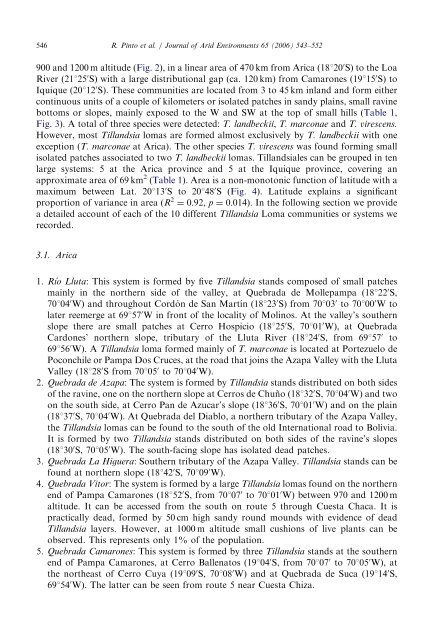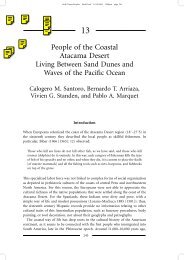Geographical distribution of Tillandsia lomas in the Atacama ... - IEB
Geographical distribution of Tillandsia lomas in the Atacama ... - IEB
Geographical distribution of Tillandsia lomas in the Atacama ... - IEB
You also want an ePaper? Increase the reach of your titles
YUMPU automatically turns print PDFs into web optimized ePapers that Google loves.
546ARTICLE IN PRESSR. P<strong>in</strong>to et al. / Journal <strong>of</strong> Arid Environments 65 (2006) 543–552900 and 1200 m altitude (Fig. 2), <strong>in</strong> a l<strong>in</strong>ear area <strong>of</strong> 470 km from Arica (18120 0 S) to <strong>the</strong> LoaRiver (21125 0 S) with a large <strong>distribution</strong>al gap (ca. 120 km) from Camarones (19115 0 S) toIquique (20112 0 S). These communities are located from 3 to 45 km <strong>in</strong>land and form ei<strong>the</strong>rcont<strong>in</strong>uous units <strong>of</strong> a couple <strong>of</strong> kilometers or isolated patches <strong>in</strong> sandy pla<strong>in</strong>s, small rav<strong>in</strong>ebottoms or slopes, ma<strong>in</strong>ly exposed to <strong>the</strong> W and SW at <strong>the</strong> top <strong>of</strong> small hills (Table 1,Fig. 3). A total <strong>of</strong> three species were detected: T. landbeckii, T. marconae and T. virescens.However, most <strong>Tillandsia</strong> <strong>lomas</strong> are formed almost exclusively by T. landbeckii with oneexception (T. marconae at Arica). The o<strong>the</strong>r species T. virescens was found form<strong>in</strong>g smallisolated patches associated to two T. landbeckii <strong>lomas</strong>. <strong>Tillandsia</strong>les can be grouped <strong>in</strong> tenlarge systems: 5 at <strong>the</strong> Arica prov<strong>in</strong>ce and 5 at <strong>the</strong> Iquique prov<strong>in</strong>ce, cover<strong>in</strong>g anapproximate area <strong>of</strong> 69 km 2 (Table 1). Area is a non-monotonic function <strong>of</strong> latitude with amaximum between Lat. 20113 0 S to 20148 0 S (Fig. 4). Latitude expla<strong>in</strong>s a significantproportion <strong>of</strong> variance <strong>in</strong> area (R 2 ¼ 0:92, p ¼ 0:014). In <strong>the</strong> follow<strong>in</strong>g section we providea detailed account <strong>of</strong> each <strong>of</strong> <strong>the</strong> 10 different <strong>Tillandsia</strong> Loma communities or systems werecorded.3.1. Arica1. Río Lluta: This system is formed by five <strong>Tillandsia</strong> stands composed <strong>of</strong> small patchesma<strong>in</strong>ly <strong>in</strong> <strong>the</strong> nor<strong>the</strong>rn side <strong>of</strong> <strong>the</strong> valley, at Quebrada de Mollepampa (18122 0 S,70104 0 W) and throughout Cordo´n de San Martı´n (18123 0 S) from 70103 0 to 70100 0 Wtolater reemerge at 69157 0 W <strong>in</strong> front <strong>of</strong> <strong>the</strong> locality <strong>of</strong> Mol<strong>in</strong>os. At <strong>the</strong> valley’s sou<strong>the</strong>rnslope <strong>the</strong>re are small patches at Cerro Hospicio (18125 0 S, 70101 0 W), at QuebradaCardones’ nor<strong>the</strong>rn slope, tributary <strong>of</strong> <strong>the</strong> Lluta River (18124 0 S, from 69157 0 to69156 0 W). A <strong>Tillandsia</strong> loma formed ma<strong>in</strong>ly <strong>of</strong> T. marconae is located at Portezuelo dePoconchile or Pampa Dos Cruces, at <strong>the</strong> road that jo<strong>in</strong>s <strong>the</strong> Azapa Valley with <strong>the</strong> LlutaValley (18128 0 S from 70105 0 to 70104 0 W).2. Quebrada de Azapa: The system is formed by <strong>Tillandsia</strong> stands distributed on both sides<strong>of</strong> <strong>the</strong> rav<strong>in</strong>e, one on <strong>the</strong> nor<strong>the</strong>rn slope at Cerros de Chun˜o (18132 0 S, 70104 0 W) and twoon <strong>the</strong> south side, at Cerro Pan de Azucar’s slope (18136 0 S, 70101 0 W) and on <strong>the</strong> pla<strong>in</strong>(18137 0 S, 70104 0 W). At Quebrada del Diablo, a nor<strong>the</strong>rn tributary <strong>of</strong> <strong>the</strong> Azapa Valley,<strong>the</strong> <strong>Tillandsia</strong> <strong>lomas</strong> can be found to <strong>the</strong> south <strong>of</strong> <strong>the</strong> old International road to Bolivia.It is formed by two <strong>Tillandsia</strong> stands distributed on both sides <strong>of</strong> <strong>the</strong> rav<strong>in</strong>e’s slopes(18130 0 S, 70105 0 W). The south-fac<strong>in</strong>g slope has isolated dead patches.3. Quebrada La Higuera: Sou<strong>the</strong>rn tributary <strong>of</strong> <strong>the</strong> Azapa Valley. <strong>Tillandsia</strong> stands can befound at nor<strong>the</strong>rn slope (18142 0 S, 70109 0 W).4. Quebrada Vitor: The system is formed by a large <strong>Tillandsia</strong> <strong>lomas</strong> found on <strong>the</strong> nor<strong>the</strong>rnend <strong>of</strong> Pampa Camarones (18152 0 S, from 70107 0 to 70101 0 W) between 970 and 1200 maltitude. It can be accessed from <strong>the</strong> south on route 5 through Cuesta Chaca. It ispractically dead, formed by 50 cm high sandy round mounds with evidence <strong>of</strong> dead<strong>Tillandsia</strong> layers. However, at 1000 m altitude small cushions <strong>of</strong> live plants can beobserved. This represents only 1% <strong>of</strong> <strong>the</strong> population.5. Quebrada Camarones: This system is formed by three <strong>Tillandsia</strong> stands at <strong>the</strong> sou<strong>the</strong>rnend <strong>of</strong> Pampa Camarones, at Cerro Ballenatos (19104 0 S, from 70107 0 to 70105 0 W), at<strong>the</strong> nor<strong>the</strong>ast <strong>of</strong> Cerro Cuya (19109 0 S, 70108 0 W) and at Quebrada de Suca (19114 0 S,69154 0 W). The latter can be seen from route 5 near Cuesta Chiza.
















